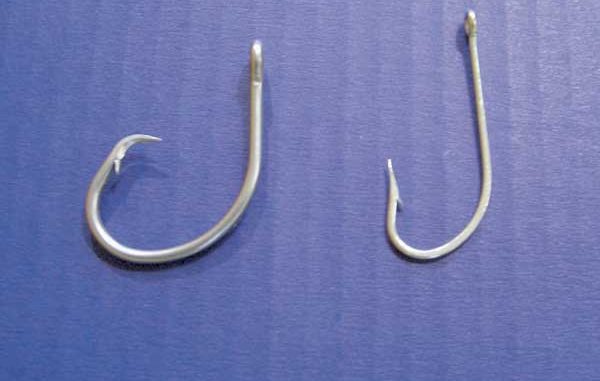
Circle hooks are becoming a hot tackle item, because they offer a better chance for fish to be released alive.
A circular hook is a bit of an oxymoron, but a circle hook is actually shaped like three-quarters of a circle, with a barbed point that turns back towards the shank. They are designed to hook fish in the corner of the mouth every time, which makes for a better fighting fish — and a healthier fish when everything is done.
Any fisherman worth his salt has fought a J-style hook out of a gut-hooked fish — and felt like he has done that fish a disservice. The S.C. Department of Natural Resources stresses the importance of circle hooks as one of the keys to successful catch-and-release fishing.
A couple of other keys are:
* Don’t fight the fish any longer than necessary to avoid fish-exhaustion;
* Get the fish back in the water as quickly as possible. Cameras should be readily available for any photo opportunities; plan ahead for the sake of the fish.
I have some circle hooks in my tackle box, but they are only larger sizes and reserved for the off chance I do some tarpon fishing. Then, dining with some friends, I overheard talk about circle hooks being used all the time — for all of their fishing.
Could this be right? I discovered that circle hooks are being used for both inshore saltwater fishing and offshore trolling, so I decided to take a closer look at the conservation behind circle hooks.
The first surprise was their history. Native Americans from the west coast carved something similar to the circle hook out of bone, while fishermen in Japan and other Pacific islands are known to have used them.
I’m also so betting that our Edisto, Kiawah, Winyah and other coastal tribes made good use of fish-hook ingenuity.
Circle hooks have been used for decades by long-line fisherman. Long-lining is a form of commercial fishing that was glorified in the film The Perfect Storm.
Long-liners, themselves a controversial subject in conservation circles, favor circle hooks for all the right reasons. They fish using slack lines with baited hooks deployed and left to sit in the ocean. Since circle-hooks generally hook fish in the mouth, there is little mortality until they come back to check their hooks. It made me wonder what else we might learn from commercial fishermen.
As a veteran member of DNR’s recreational fish-tagging program, I was educated recently that when using a J-hook, you run the risk of needless mortality.
If you catch a spot-tail and are pleased that he is hooked in the corner of the mouth — which makes for an easy de-hooking — you release him thinking that all is well. However, it may be that the J-hook was initially snagged in the gut or gills, then yanked free before being secured in his bony mouth. Fish with damaged gills and internal injuries may swim off, but they are destined to die due to this rough treatment.
When using a traditional J-hook, you wait until you feel the fish bite, and then set the hook by lifting the rod tip. If you are targeting a fish that vacuums up the water surrounding his prey with its down-turned mouth — such as a spot-tail — when you snap the rod tip up, the hook may already be inside the fish’s belly. Fish that are hooked in the gut, the throat or the gill area have less chance to survive, and no angler releases his fish because he wants it to perish.
When using circle hooks it’s important to remember NOT to set the hook. Rather, apply steady force and let the hook and the fish do the work for you. Circle hooks can be swallowed into a fish’s stomach, but there is some certainty that it will slide back out when pressure is applied.
As the hook gets ready to slide out the mouth, it rotates and catches the fish in the corner of the jaw. Fewer foul hooks equals more healthy fish swimming around, waiting to strike another angler’s lines.
Most hooks come with a barb on the point of the hook, designed to keep the hook set where it snags. Another way to practice sportsmanship is to remove the barb by filing it off. If a fish is well hooked and pulling against you, it’s unlikely that you’ll be at a disadvantage for using a barbless hook.
Captain Dan Kipnis has been using circle hooks for 35 years. He said, “When fishing with bait, a circle hook can always be used.”
The only time circle hooks don’t work is when fishing artificial lures. Kipnis’s expertise in offshore fishing allows him to say with confidence that “using circle hooks gives the best hook-up ratio by far, and it limits the times a billfish will spit the hook.”
The Billfish Foundation has moved to a policy of allowing only circle hooks in its tournaments in Central and South America. Kipnis said that a similar rule is voluntarily enforced in Miami billfish events, and that it will one day be the standard for all Atlantic billfish tourneys.
Circle hooks are a conservation tool that can benefit everyone’s tackle box. Give fishermen good ideas, and they will add their own know-how to make it work in any particular fishery. So give circle hooks a try, and help decrease fish mortality.



Be the first to comment